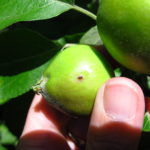It may seem like the worst is over, but apple growers should continue to be vigilant and apply fungicides even as we approach the end of the ascospore discharge period. Leaves are still highly susceptible to both primary and secondary apple scab infection until the terminal bud has set and the leaves have hardened off. Our cool, wet, crazy spring resulted in the late formation of primary scab lesions coupled with a long growth period, meaning more opportunity for scab infection. As a result growers that scouted earlier and found no scab may think their orchard is a lot ‘cleaner’ than it really is. Those hard-to-detect primary lesions can churn out 95,000 conidia per lesion! This makes it difficult to determine if the later lesions are late primary infections or actually secondary infections. Let’s face it: No one cares except the plant pathologists. Upshot: Scab control is really, really important through third cover.
And while we’re at it, let’s remind ourselves that bitter rot control is equally important. Trying to squeeze in that last application of mancozeb before the 77-day PHI is never a bad idea. If you are past that point, applications of 7+11 (Pristine; Luna Sensation; Merivon) will also provide good protection. Look for early signs of infection (Fig. 1), or feeding injury by stink bugs, too. We are trying to get a handle on that relationship (stinkbug feeding serving as an infection court for the bitter rot pathogen) this year in our spray trials and hope to keep you posted.
- Figure 1 Trying to determine which, if any of these lesions, may be early infection of the bitter rot pathogen, Colletotrichum spp
- Figure 1 Trying to determine which, if any of these lesions, may be early infection of the bitter rot pathogen, Colletotrichum spp

